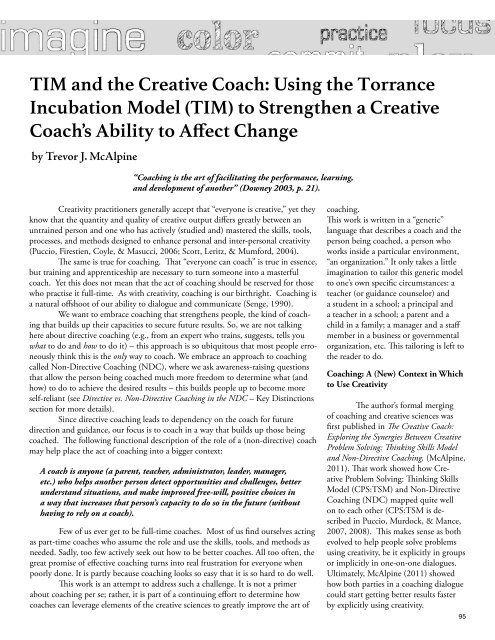Torrance Journal for Applied Creativity
TorranceJournal_V1
TorranceJournal_V1
You also want an ePaper? Increase the reach of your titles
YUMPU automatically turns print PDFs into web optimized ePapers that Google loves.
TIM and the Creative Coach: Using the <strong>Torrance</strong><br />
Incubation Model (TIM) to Strengthen a Creative<br />
Coach’s Ability to Affect Change<br />
by Trevor J. McAlpine<br />
“Coaching is the art of facilitating the per<strong>for</strong>mance, learning,<br />
and development of another” (Downey 2003, p. 21).<br />
<strong>Creativity</strong> practitioners generally accept that “everyone is creative,” yet they<br />
know that the quantity and quality of creative output differs greatly between an<br />
untrained person and one who has actively (studied and) mastered the skills, tools,<br />
processes, and methods designed to enhance personal and inter-personal creativity<br />
(Puccio, Firestien, Coyle, & Masucci, 2006; Scott, Leritz, & Mum<strong>for</strong>d, 2004).<br />
The same is true <strong>for</strong> coaching. That “everyone can coach” is true in essence,<br />
but training and apprenticeship are necessary to turn someone into a masterful<br />
coach. Yet this does not mean that the act of coaching should be reserved <strong>for</strong> those<br />
who practise it full-time. As with creativity, coaching is our birthright. Coaching is<br />
a natural offshoot of our ability to dialogue and communicate (Senge, 1990).<br />
We want to embrace coaching that strengthens people, the kind of coaching<br />
that builds up their capacities to secure future results. So, we are not talking<br />
here about directive coaching (e.g., from an expert who trains, suggests, tells you<br />
what to do and how to do it) – this approach is so ubiquitous that most people erroneously<br />
think this is the only way to coach. We embrace an approach to coaching<br />
called Non-Directive Coaching (NDC), where we ask awareness-raising questions<br />
that allow the person being coached much more freedom to determine what (and<br />
how) to do to achieve the desired results – this builds people up to become more<br />
self-reliant (see Directive vs. Non-Directive Coaching in the NDC – Key Distinctions<br />
section <strong>for</strong> more details).<br />
Since directive coaching leads to dependency on the coach <strong>for</strong> future<br />
direction and guidance, our focus is to coach in a way that builds up those being<br />
coached. The following functional description of the role of a (non-directive) coach<br />
may help place the act of coaching into a bigger context:<br />
A coach is anyone (a parent, teacher, administrator, leader, manager,<br />
etc.) who helps another person detect opportunities and challenges, better<br />
understand situations, and make improved free-will, positive choices in<br />
a way that increases that person’s capacity to do so in the future (without<br />
having to rely on a coach).<br />
Few of us ever get to be full-time coaches. Most of us find ourselves acting<br />
as part-time coaches who assume the role and use the skills, tools, and methods as<br />
needed. Sadly, too few actively seek out how to be better coaches. All too often, the<br />
great promise of effective coaching turns into real frustration <strong>for</strong> everyone when<br />
poorly done. It is partly because coaching looks so easy that it is so hard to do well.<br />
This work is an attempt to address such a challenge. It is not a primer<br />
about coaching per se; rather, it is part of a continuing ef<strong>for</strong>t to determine how<br />
coaches can leverage elements of the creative sciences to greatly improve the art of<br />
coaching.<br />
This work is written in a “generic”<br />
language that describes a coach and the<br />
person being coached, a person who<br />
works inside a particular environment,<br />
“an organization.” It only takes a little<br />
imagination to tailor this generic model<br />
to one’s own specific circumstances: a<br />
teacher (or guidance counselor) and<br />
a student in a school; a principal and<br />
a teacher in a school; a parent and a<br />
child in a family; a manager and a staff<br />
member in a business or governmental<br />
organization, etc. This tailoring is left to<br />
the reader to do.<br />
Coaching: A (New) Context in Which<br />
to Use <strong>Creativity</strong><br />
The author’s <strong>for</strong>mal merging<br />
of coaching and creative sciences was<br />
first published in The Creative Coach:<br />
Exploring the Synergies Between Creative<br />
Problem Solving: Thinking Skills Model<br />
and Non-Directive Coaching, (McAlpine,<br />
2011). That work showed how Creative<br />
Problem Solving: Thinking Skills<br />
Model (CPS:TSM) and Non-Directive<br />
Coaching (NDC) mapped quite well<br />
on to each other (CPS:TSM is described<br />
in Puccio, Murdock, & Mance,<br />
2007, 2008). This makes sense as both<br />
evolved to help people solve problems<br />
using creativity, be it explicitly in groups<br />
or implicitly in one-on-one dialogues.<br />
Ultimately, McAlpine (2011) showed<br />
how both parties in a coaching dialogue<br />
could start getting better results faster<br />
by explicitly using creativity.<br />
95


